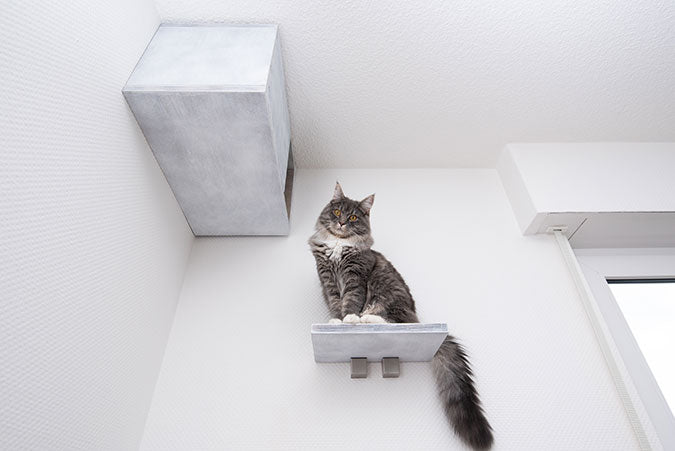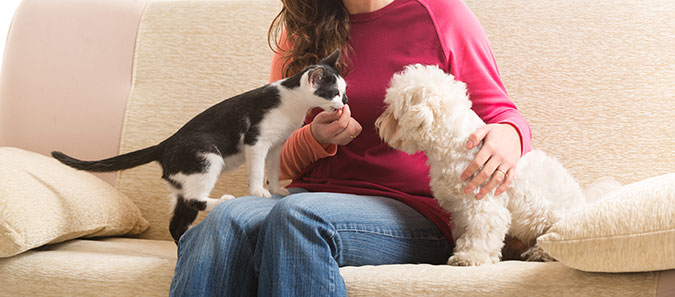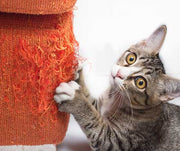My Cat is Afraid of the New Dog

You've just adopted a new dog and are bringing it home for the first time. However, as soon as your cat sees the new pup, she runs away scared. Most cats tend to be afraid of dogs and for good reason – many dogs are bigger than cats and will oftentimes chase or try to play with them, even if it's simply out of curiosity and not aggression. Despite their differences, though, it is possible for most cats and dogs to get along and live peacefully together with a little bit of persistence, patience, and training.
Before bringing your new dog home, be sure you take a few things into consideration. Start by first assessing your cat's personality. Does he or she get along well with strangers? If your cat tends to run away from people and other creatures, this may cause a dog to think they are playing and want to chase them. If you have an elderly cat or a cat with health issues, getting a young, energetic puppy might not be the best idea. It can also be helpful if the dog you're adopting has previously lived with cats or if your cat has had some experience being around a dog.
INTRODUCING YOUR PETS TO EACH OTHER
When it comes time for you to introduce your new dog to your cat, be sure you do it at your home. Bringing your cat to a new environment will just make things more stressful and difficult. Plus, when your cat is at home, she'll be able to easily run and hide to their favorite spot if they're feeling anxious. Your cat essentially has the home field advantage.

Figure out a good way to keep both of your pets separated when you bring your new dog home. One good idea is to start off by giving your cat free roam of the house while you keep your new dog confined to one room or space, such as a kennel, wire crate, or exercise pen. It might help your cat adjust easier if they have a high place to hump to (such as a bookshelf, a cat tree, etc.) so that they maintain a safe distance from the dog. If it's possible in your home, it's a good idea to keep your dog contained to one level and your cat to another, blocking the stairs with a gate or something your dog can't jump over. Having a screen or baby gate can be a great option as this will allow your pets to see and sniff each other without fully interacting. Whichever way works best for you to separate them, just make sure that your cat has access to its litter box and that both pets have access to food and water without the other one getting into it.
LEASHED INTRODUCTIONS
The next step towards introducing your new dog to your cat is by allowing them to be in the same room or space, but keeping your dog secured on a leash. Start a good distance away from the cat, and don't force any interactions between the two animals. Let them take things at their own pace. You cat may hiss and run away, and this is normal! Eventually, your dog should settle down and ignore your cat, and your cat will then feel comfortable enough to go about his or her own business. However, this make take several days or weeks, so be patient and don't rush it! If this does not go over well the first time, you may want to go back to the first step of keeping your animals in separate spaces. If things seem to be going smoothly, you can slowly begin to decrease the distance of their leashed interactions. Also be sure to keep your cat and dog separated any time you leave the house and during the night. It's a good idea to keep your dog in a kennel or wire crate and let your cat have free roam over the house during the nighttime hours, especially since cats are nocturnal.
As you are going through the process of introducing your new dog to your cat, be sure that you praise any positive behavior from both of them. If you notice your cat bravely venturing out, give him or her verbal praise and treats. You can also praise your dog by giving treats when you notice him or her ignoring the cat or gently interacting with it.

One of the biggest things to remember when it comes to adjusting your cat to your new dog is that this will take time. Though it's different with every animal and every situation, you should be prepared for introductions to take longer than you may anticipate. Some cats may take weeks or even months before they are fully adjusted to another animal living in their space. After a few days of your cat bring comfortable with leashed introductions, you can take your dog off of its leash. Be sure to spend some time supervising your dog's interactions with your cat, especially initially, and be ready to put your dog back on its leash if there is any aggression or rough play.
DO I NEED PROFESSIONAL HELP?
If you notice ongoing aggression or behaviors such as snapping or growling, you may want to seek professional help. You don't want either of your pets injuring each other, and you also don't want to have to deal with all of this by yourself! A professional animal behaviorist will be able to help you out and give your advice for your specific situation. You also want to be sure that your cat is still eating and using their litter box regularly. If they aren't, they may be under a lot of stress due to this significant change in their home, and you will want to seek out some advice from a professional. After all, you want both of your pets to be happy and healthy!
Having a dog and cat living in the same home may not be easy at first, but most times, both of your pets will be able to adjust and live peacefully together! Start slow and stay patient and kind towards both of your animals. They'll be getting along with each other in no time!
Previous article

Next article

Related posts
View all-

National K9 Veterans Day: Why and How to Celebrate
National K9 Veterans Day is celebrated every year on March 13th. This year its on Saturday March 13th, 2024. This day was established to recognize and celebrate the contributions that Military Working Dogs.
Read Article -

Puppy Training Tips
Training your pup from day one helps set a solid foundation for good behavior and a well-adjusted adult dog. Puppies thrive on structure, and a predictable routine makes learning easier.
Read Article -

Spring Cleaning Tips for Pet Parents
Say goodbye to the winter germs and hello to all the new spring smells! The beginning of spring is the perfect time to clean your house. For pet owners, this can mean more in-depth cleaning in areas other people don't have to worry about. We will give you some helpful tips and tricks so that cleaning up after your pet seems a little less daunting. Read Article



